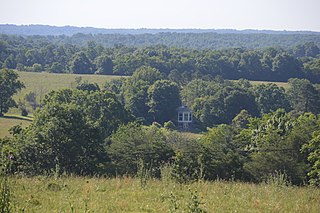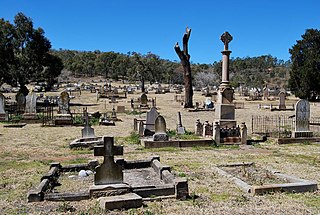
A cemetery, burial ground, gravesite, graveyard, or a green space called a memorial park, is a place where the remains of dead people are buried or otherwise interred. The word cemetery implies that the land is specifically designated as a burial ground and originally applied to the Roman catacombs. The term graveyard is often used interchangeably with cemetery, but a graveyard primarily refers to a burial ground within a churchyard.

Old Chapel Hill Cemetery is a graveyard and national historic district located on the campus of the University of North Carolina at Chapel Hill in Chapel Hill, North Carolina.

Winchester National Cemetery is a United States National Cemetery located in the city of Winchester in Frederick County, Virginia. Administered by the United States Department of Veterans Affairs, it encompasses 4.9 acres (2.0 ha), and as of the end of 2005, it had 5,561 interments. It is closed to new interments.

The Hurricane of 1928 African-American Mass Burial Site is a pauper's cemetery and mass grave in West Palm Beach, Florida. It is listed on the U.S. National Register of Historic Places. The cemetery is situated near the junction of 25th Street and Tamarind Avenue between I-95 and U.S. Route 1. The site is the location in which 674 bodies of African Americans or those of an unknown race were buried following the 1928 Okeechobee hurricane, while most of the white victims of the storm received a proper burial at Woodlawn Cemetery due to segregation laws.

The Minneapolis Pioneers and Soldiers Memorial Cemetery is the oldest extant cemetery in Minneapolis, Minnesota, United States. It was established in 1858 as a privately owned burial ground known as Minneapolis Cemetery or Layman's Cemetery. By 1919 it was full, with more than 27,000 bodies, and was closed by the city government. Only a handful of burials have taken place there since.

The West Parish Burying Ground, also known as the River Street Burying Ground or River Street Cemetery, is a cemetery located at River and Cherry streets in West Newton, Massachusetts, and is listed on the National Register of Historic Places. Established in 1777, the cemetery is owned and maintained by the City of Newton; the Second Church in Newton, its original owner, was known as the West Parish.

Gilead Cemetery is located in the town of Carmel, New York, United States. It is off a bend in Mechanic Street 1.5 miles (2.4 km) south of the hamlet of Carmel, seat of Putnam County.

Greenwood Cemetery occupies 7.9 acres (32,000 m2) on Oak Avenue between Greenwood and Lake Streets, west of Old Woodward Avenue, in Birmingham, Michigan. The gently rolling landscape contains over 3,000 graves; 650 date from the nineteenth century. The grounds display a plethora of limestone, marble, cast zinc and granite monuments. An iron fence with low stone piers flanking the entrance fronts the cemetery. In 1885 the Greenwood Cemetery Association was established to maintain the burial ground. When the Association was dissolved in 1946, the city of Birmingham assumed the ownership and maintenance of the cemetery.

Mansfield Center Cemetery is a small cemetery in the Mansfield Center section of Mansfield, Connecticut. Established in 1693, it is one of the few surviving elements of Mansfield's early colonial settlement history. It also has a distinguished array of funerary markers carved by acknowledged master's across eastern Connecticut. It was listed on the National Register of Historic Places in 1992.

Speed the Plough is a farm in Amherst County, Virginia near the village of Elon, listed on the National Register of Historic Places. The farm represents a succession of farm buildings from about 1799 to 1940. Its main house, a two-story brick structure, was built for William Dearing (1820–1862). Dearing held about fourteen slaves on the farm prior to the American Civil War. The property was sold out of the Dearing family about 1915 and the land was converted to an orchard by the Montrose Fruit Company, abandoning the house and most buildings. The land and house were later acquired by Rowland Lea (1872–1960). His partner, George Stevens (1868–1941), built a stone summer residence, the Rock Cottage, on the property. Several other buildings have been renovated for residential use and comprise a small village in what are now pasture lands.
Columbian Harmony Cemetery was an African-American cemetery that formerly existed at 9th Street NE and Rhode Island Avenue NE in Washington, D.C., in the United States. Constructed in 1859, it was the successor to the smaller Harmoneon Cemetery in downtown Washington. All graves in the cemetery were moved to National Harmony Memorial Park in Landover, Maryland, in 1959. The cemetery site was sold to developers, and a portion used for the Rhode Island Avenue – Brentwood Washington Metro station.

The Searles Hill Cemetery is a historic cemetery near the junction of Searles Hill Road and Old Queen Lake Road in Phillipston, Massachusetts. Established in 1777 on land donated by an early settler for the purpose in 1759, it is the town's oldest cemetery. It was listed on the National Register of Historic Places on September 15, 2011.

Drayton and Toowoomba Cemetery is a heritage-listed cemetery at the corner of South Street and Anzac Avenue, Harristown, Queensland, Australia. It was surveyed in May 1850, and is one of the earliest surviving cemeteries in Queensland. The cemetery is large, containing over 45,000 burials. It has been run by the City of Toowoomba, and its successor the Toowoomba Regional Council, since 1974; previously it was run by government-appointed trustees. Many prominent people associated with the Darling Downs are buried in the cemetery, and all sections of the cemetery remain in use. Notable Toowoomba stonemasons R. C. Ziegler & Son, Henry Bailey, Walter Bruce, John H. Wagner and the Bruce Brothers are all associated with monuments within the cemetery.

Allora Cemetery is a heritage-listed cemetery on Allora-Clifton Road, Allora, Southern Downs Region, Queensland, Australia. It was established in 1864. It was added to the Queensland Heritage Register on 27 April 2001.

Mount Morgan Cemetery is a heritage-listed cemetery at East Street, Mount Morgan, Rockhampton Region, Queensland, Australia. It was established in 1886. It was added to the Queensland Heritage Register on 21 October 1992.

Clermont Cemetery is a heritage-listed cemetery at Cemetery Road, Clermont, Isaac Region, Queensland, Australia. It was established in 1866. It was added to the Queensland Heritage Register on 6 August 2010.

Flemington Road Cemetery is a heritage-listed cemetery at Flemington Road, Bowen, Whitsunday Region, Queensland, Australia. It was built from 1878 to 1954. It is also known as Bowen Cemetery. It was added to the Queensland Heritage Register on 23 July 1999.

The Pearce Family Cemetery is a heritage-listed former farming land and now cemetery located at 257 Seven Hills Road, Bella Vista in The Hills Shire local government area of New South Wales, Australia. It is also known as the Pearce Cemetery. The property is privately owned. It was added to the New South Wales State Heritage Register on 2 April 1999.

Pioneers Rest is the oldest public cemetery in Fort Worth, Texas and one of the oldest in Tarrant County. Its use as a burial ground began in the summer of 1850, shortly after the fort was established by the United States Army.

The Temple Beth Israel Cemetery, also known as the Hebrew Cemetery, is a Jewish cemetery located at 420 North West Avenue in Jackson, Michigan. It was listed on the National Register of Historic Places in 2009.






















